Science and Materials: Regulations, Testing, and Selection Report
VerifiedAdded on 2023/01/04
|10
|3264
|93
Report
AI Summary
This report provides a comprehensive overview of science and materials in the context of construction. It begins by examining the impact of regulations on the use, storage, and handling of various construction materials, emphasizing the importance of proper storage areas, pedestrian routes, and safe handling practices. The report then delves into material environmental profiling and lifecycle assessment, using cement as a case study, and highlights the benefits of product declaration and environmental certification, such as cost savings and improved environmental safety. The report also details relevant testing procedures for materials like timber, bricks, sand, and concrete, discussing the implications of test results. Furthermore, the report explores material selection strategies for a 10-story mixed-use building, considering bricks, cement, steel, and sand. It underscores the significance of selecting high-quality materials to ensure building strength and durability.
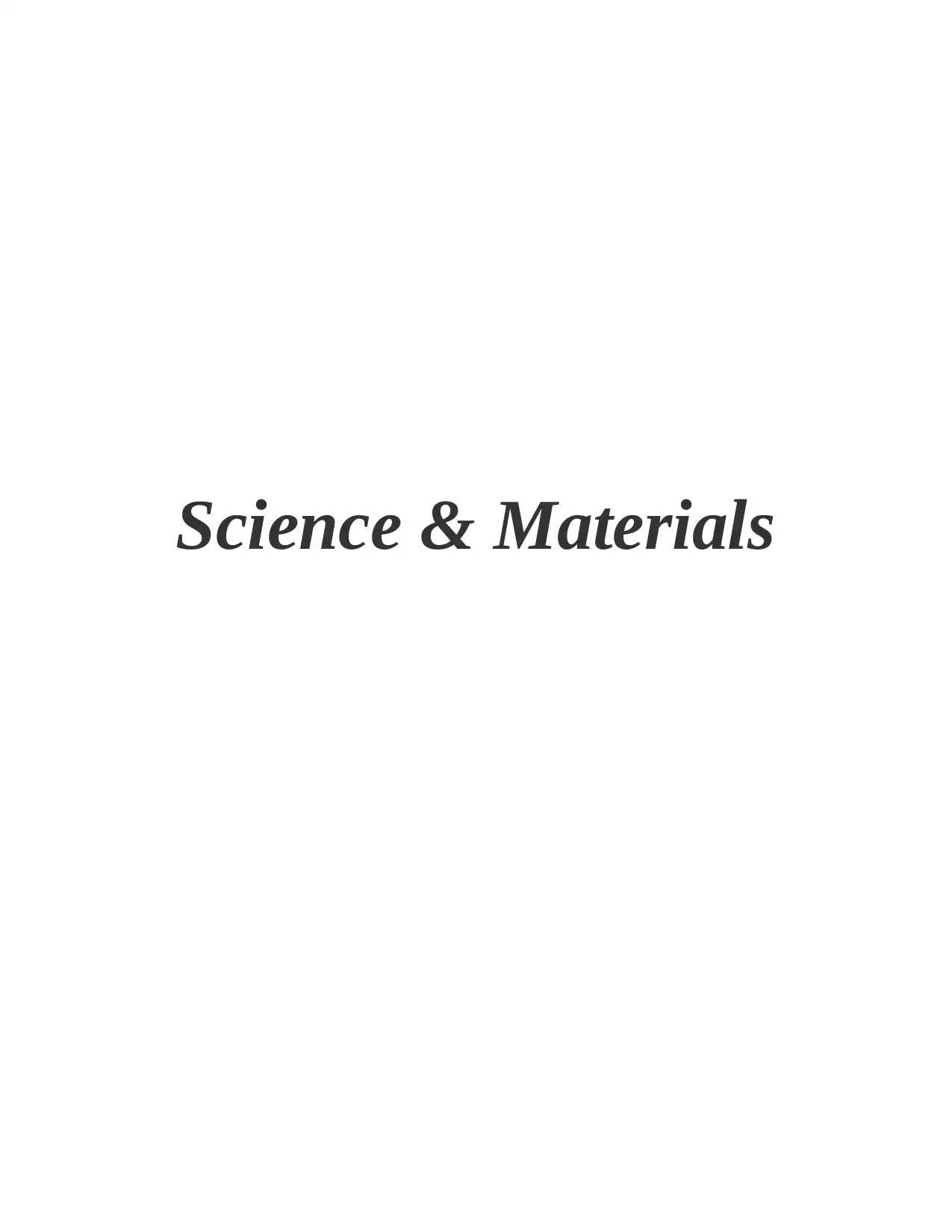
Science & Materials
Secure Best Marks with AI Grader
Need help grading? Try our AI Grader for instant feedback on your assignments.
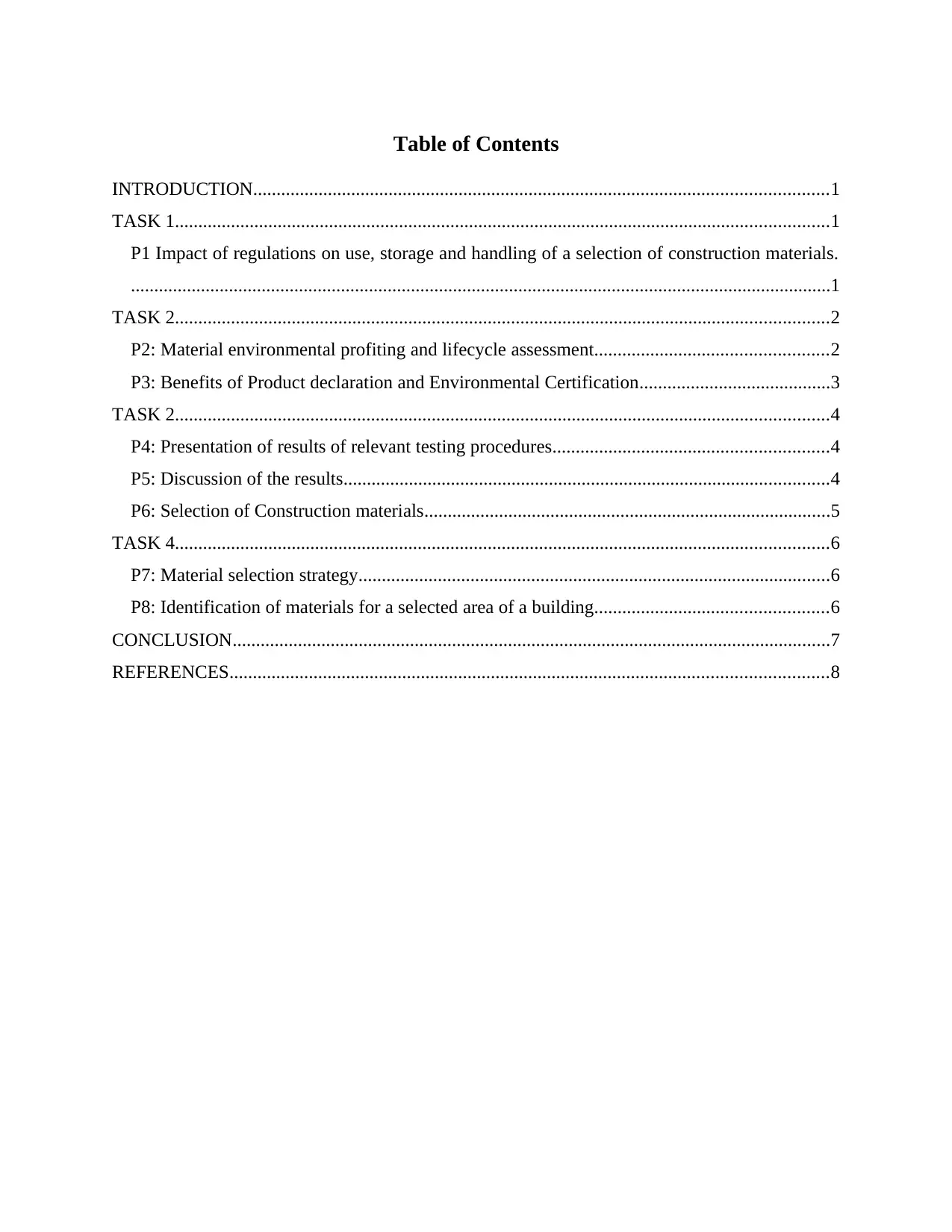
Table of Contents
INTRODUCTION...........................................................................................................................1
TASK 1............................................................................................................................................1
P1 Impact of regulations on use, storage and handling of a selection of construction materials.
......................................................................................................................................................1
TASK 2............................................................................................................................................2
P2: Material environmental profiting and lifecycle assessment..................................................2
P3: Benefits of Product declaration and Environmental Certification.........................................3
TASK 2............................................................................................................................................4
P4: Presentation of results of relevant testing procedures...........................................................4
P5: Discussion of the results........................................................................................................4
P6: Selection of Construction materials.......................................................................................5
TASK 4............................................................................................................................................6
P7: Material selection strategy.....................................................................................................6
P8: Identification of materials for a selected area of a building..................................................6
CONCLUSION................................................................................................................................7
REFERENCES................................................................................................................................8
INTRODUCTION...........................................................................................................................1
TASK 1............................................................................................................................................1
P1 Impact of regulations on use, storage and handling of a selection of construction materials.
......................................................................................................................................................1
TASK 2............................................................................................................................................2
P2: Material environmental profiting and lifecycle assessment..................................................2
P3: Benefits of Product declaration and Environmental Certification.........................................3
TASK 2............................................................................................................................................4
P4: Presentation of results of relevant testing procedures...........................................................4
P5: Discussion of the results........................................................................................................4
P6: Selection of Construction materials.......................................................................................5
TASK 4............................................................................................................................................6
P7: Material selection strategy.....................................................................................................6
P8: Identification of materials for a selected area of a building..................................................6
CONCLUSION................................................................................................................................7
REFERENCES................................................................................................................................8
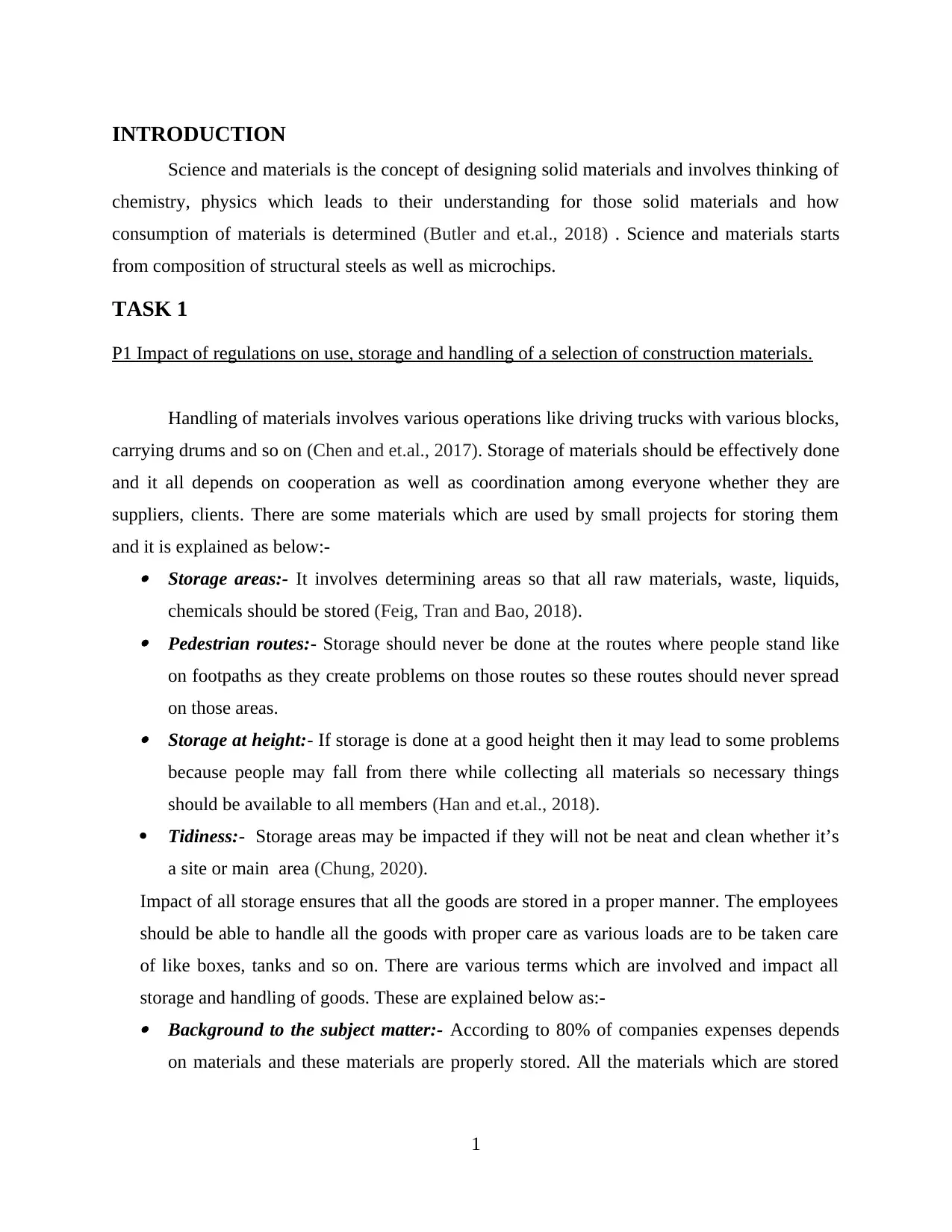
INTRODUCTION
Science and materials is the concept of designing solid materials and involves thinking of
chemistry, physics which leads to their understanding for those solid materials and how
consumption of materials is determined (Butler and et.al., 2018) . Science and materials starts
from composition of structural steels as well as microchips.
TASK 1
P1 Impact of regulations on use, storage and handling of a selection of construction materials.
Handling of materials involves various operations like driving trucks with various blocks,
carrying drums and so on (Chen and et.al., 2017). Storage of materials should be effectively done
and it all depends on cooperation as well as coordination among everyone whether they are
suppliers, clients. There are some materials which are used by small projects for storing them
and it is explained as below:- Storage areas:- It involves determining areas so that all raw materials, waste, liquids,
chemicals should be stored (Feig, Tran and Bao, 2018). Pedestrian routes:- Storage should never be done at the routes where people stand like
on footpaths as they create problems on those routes so these routes should never spread
on those areas. Storage at height:- If storage is done at a good height then it may lead to some problems
because people may fall from there while collecting all materials so necessary things
should be available to all members (Han and et.al., 2018).
Tidiness:- Storage areas may be impacted if they will not be neat and clean whether it’s
a site or main area (Chung, 2020).
Impact of all storage ensures that all the goods are stored in a proper manner. The employees
should be able to handle all the goods with proper care as various loads are to be taken care
of like boxes, tanks and so on. There are various terms which are involved and impact all
storage and handling of goods. These are explained below as:- Background to the subject matter:- According to 80% of companies expenses depends
on materials and these materials are properly stored. All the materials which are stored
1
Science and materials is the concept of designing solid materials and involves thinking of
chemistry, physics which leads to their understanding for those solid materials and how
consumption of materials is determined (Butler and et.al., 2018) . Science and materials starts
from composition of structural steels as well as microchips.
TASK 1
P1 Impact of regulations on use, storage and handling of a selection of construction materials.
Handling of materials involves various operations like driving trucks with various blocks,
carrying drums and so on (Chen and et.al., 2017). Storage of materials should be effectively done
and it all depends on cooperation as well as coordination among everyone whether they are
suppliers, clients. There are some materials which are used by small projects for storing them
and it is explained as below:- Storage areas:- It involves determining areas so that all raw materials, waste, liquids,
chemicals should be stored (Feig, Tran and Bao, 2018). Pedestrian routes:- Storage should never be done at the routes where people stand like
on footpaths as they create problems on those routes so these routes should never spread
on those areas. Storage at height:- If storage is done at a good height then it may lead to some problems
because people may fall from there while collecting all materials so necessary things
should be available to all members (Han and et.al., 2018).
Tidiness:- Storage areas may be impacted if they will not be neat and clean whether it’s
a site or main area (Chung, 2020).
Impact of all storage ensures that all the goods are stored in a proper manner. The employees
should be able to handle all the goods with proper care as various loads are to be taken care
of like boxes, tanks and so on. There are various terms which are involved and impact all
storage and handling of goods. These are explained below as:- Background to the subject matter:- According to 80% of companies expenses depends
on materials and these materials are properly stored. All the materials which are stored
1
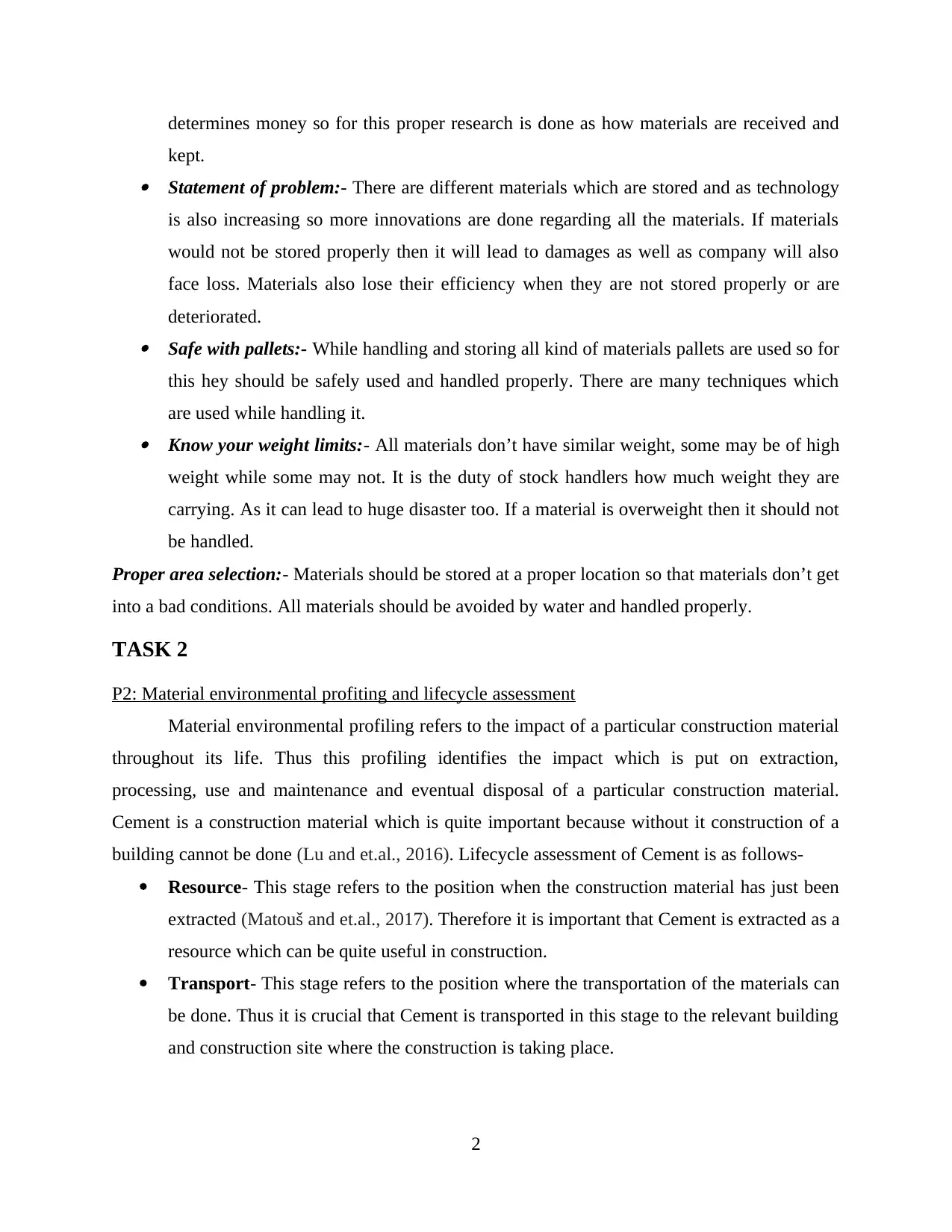
determines money so for this proper research is done as how materials are received and
kept. Statement of problem:- There are different materials which are stored and as technology
is also increasing so more innovations are done regarding all the materials. If materials
would not be stored properly then it will lead to damages as well as company will also
face loss. Materials also lose their efficiency when they are not stored properly or are
deteriorated. Safe with pallets:- While handling and storing all kind of materials pallets are used so for
this hey should be safely used and handled properly. There are many techniques which
are used while handling it. Know your weight limits:- All materials don’t have similar weight, some may be of high
weight while some may not. It is the duty of stock handlers how much weight they are
carrying. As it can lead to huge disaster too. If a material is overweight then it should not
be handled.
Proper area selection:- Materials should be stored at a proper location so that materials don’t get
into a bad conditions. All materials should be avoided by water and handled properly.
TASK 2
P2: Material environmental profiting and lifecycle assessment
Material environmental profiling refers to the impact of a particular construction material
throughout its life. Thus this profiling identifies the impact which is put on extraction,
processing, use and maintenance and eventual disposal of a particular construction material.
Cement is a construction material which is quite important because without it construction of a
building cannot be done (Lu and et.al., 2016). Lifecycle assessment of Cement is as follows-
Resource- This stage refers to the position when the construction material has just been
extracted (Matouš and et.al., 2017). Therefore it is important that Cement is extracted as a
resource which can be quite useful in construction.
Transport- This stage refers to the position where the transportation of the materials can
be done. Thus it is crucial that Cement is transported in this stage to the relevant building
and construction site where the construction is taking place.
2
kept. Statement of problem:- There are different materials which are stored and as technology
is also increasing so more innovations are done regarding all the materials. If materials
would not be stored properly then it will lead to damages as well as company will also
face loss. Materials also lose their efficiency when they are not stored properly or are
deteriorated. Safe with pallets:- While handling and storing all kind of materials pallets are used so for
this hey should be safely used and handled properly. There are many techniques which
are used while handling it. Know your weight limits:- All materials don’t have similar weight, some may be of high
weight while some may not. It is the duty of stock handlers how much weight they are
carrying. As it can lead to huge disaster too. If a material is overweight then it should not
be handled.
Proper area selection:- Materials should be stored at a proper location so that materials don’t get
into a bad conditions. All materials should be avoided by water and handled properly.
TASK 2
P2: Material environmental profiting and lifecycle assessment
Material environmental profiling refers to the impact of a particular construction material
throughout its life. Thus this profiling identifies the impact which is put on extraction,
processing, use and maintenance and eventual disposal of a particular construction material.
Cement is a construction material which is quite important because without it construction of a
building cannot be done (Lu and et.al., 2016). Lifecycle assessment of Cement is as follows-
Resource- This stage refers to the position when the construction material has just been
extracted (Matouš and et.al., 2017). Therefore it is important that Cement is extracted as a
resource which can be quite useful in construction.
Transport- This stage refers to the position where the transportation of the materials can
be done. Thus it is crucial that Cement is transported in this stage to the relevant building
and construction site where the construction is taking place.
2
Secure Best Marks with AI Grader
Need help grading? Try our AI Grader for instant feedback on your assignments.
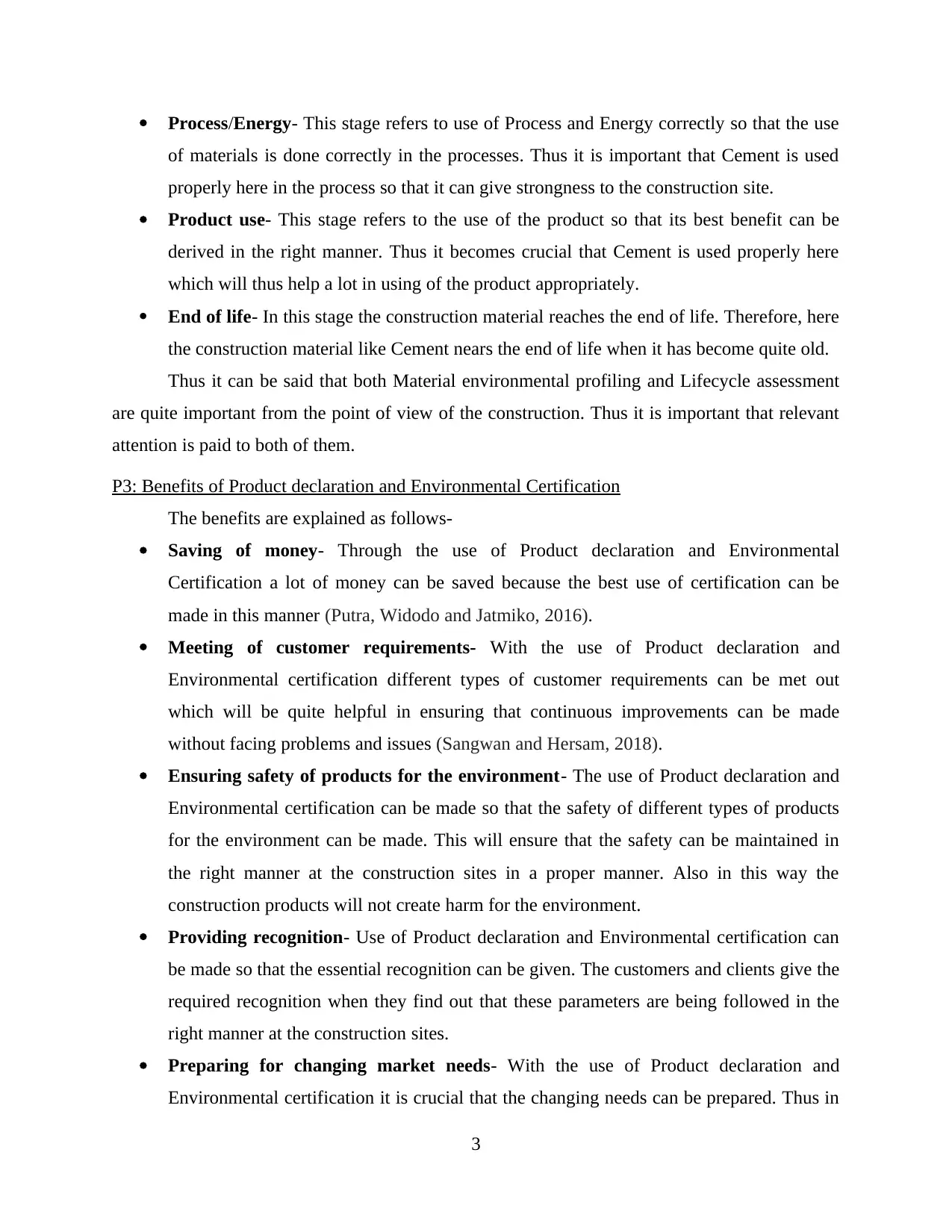
Process/Energy- This stage refers to use of Process and Energy correctly so that the use
of materials is done correctly in the processes. Thus it is important that Cement is used
properly here in the process so that it can give strongness to the construction site.
Product use- This stage refers to the use of the product so that its best benefit can be
derived in the right manner. Thus it becomes crucial that Cement is used properly here
which will thus help a lot in using of the product appropriately.
End of life- In this stage the construction material reaches the end of life. Therefore, here
the construction material like Cement nears the end of life when it has become quite old.
Thus it can be said that both Material environmental profiling and Lifecycle assessment
are quite important from the point of view of the construction. Thus it is important that relevant
attention is paid to both of them.
P3: Benefits of Product declaration and Environmental Certification
The benefits are explained as follows-
Saving of money- Through the use of Product declaration and Environmental
Certification a lot of money can be saved because the best use of certification can be
made in this manner (Putra, Widodo and Jatmiko, 2016).
Meeting of customer requirements- With the use of Product declaration and
Environmental certification different types of customer requirements can be met out
which will be quite helpful in ensuring that continuous improvements can be made
without facing problems and issues (Sangwan and Hersam, 2018).
Ensuring safety of products for the environment- The use of Product declaration and
Environmental certification can be made so that the safety of different types of products
for the environment can be made. This will ensure that the safety can be maintained in
the right manner at the construction sites in a proper manner. Also in this way the
construction products will not create harm for the environment.
Providing recognition- Use of Product declaration and Environmental certification can
be made so that the essential recognition can be given. The customers and clients give the
required recognition when they find out that these parameters are being followed in the
right manner at the construction sites.
Preparing for changing market needs- With the use of Product declaration and
Environmental certification it is crucial that the changing needs can be prepared. Thus in
3
of materials is done correctly in the processes. Thus it is important that Cement is used
properly here in the process so that it can give strongness to the construction site.
Product use- This stage refers to the use of the product so that its best benefit can be
derived in the right manner. Thus it becomes crucial that Cement is used properly here
which will thus help a lot in using of the product appropriately.
End of life- In this stage the construction material reaches the end of life. Therefore, here
the construction material like Cement nears the end of life when it has become quite old.
Thus it can be said that both Material environmental profiling and Lifecycle assessment
are quite important from the point of view of the construction. Thus it is important that relevant
attention is paid to both of them.
P3: Benefits of Product declaration and Environmental Certification
The benefits are explained as follows-
Saving of money- Through the use of Product declaration and Environmental
Certification a lot of money can be saved because the best use of certification can be
made in this manner (Putra, Widodo and Jatmiko, 2016).
Meeting of customer requirements- With the use of Product declaration and
Environmental certification different types of customer requirements can be met out
which will be quite helpful in ensuring that continuous improvements can be made
without facing problems and issues (Sangwan and Hersam, 2018).
Ensuring safety of products for the environment- The use of Product declaration and
Environmental certification can be made so that the safety of different types of products
for the environment can be made. This will ensure that the safety can be maintained in
the right manner at the construction sites in a proper manner. Also in this way the
construction products will not create harm for the environment.
Providing recognition- Use of Product declaration and Environmental certification can
be made so that the essential recognition can be given. The customers and clients give the
required recognition when they find out that these parameters are being followed in the
right manner at the construction sites.
Preparing for changing market needs- With the use of Product declaration and
Environmental certification it is crucial that the changing needs can be prepared. Thus in
3
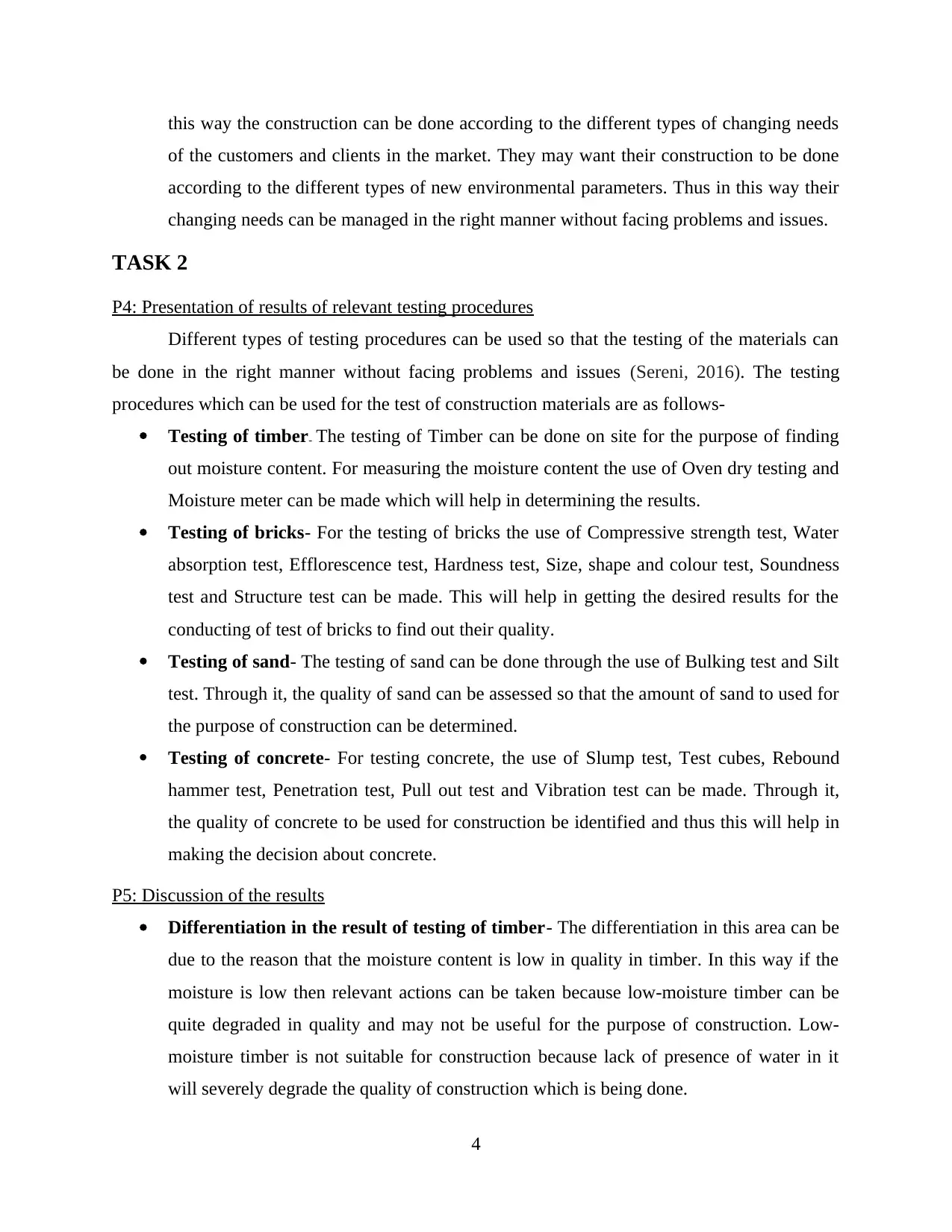
this way the construction can be done according to the different types of changing needs
of the customers and clients in the market. They may want their construction to be done
according to the different types of new environmental parameters. Thus in this way their
changing needs can be managed in the right manner without facing problems and issues.
TASK 2
P4: Presentation of results of relevant testing procedures
Different types of testing procedures can be used so that the testing of the materials can
be done in the right manner without facing problems and issues (Sereni, 2016). The testing
procedures which can be used for the test of construction materials are as follows-
Testing of timber- The testing of Timber can be done on site for the purpose of finding
out moisture content. For measuring the moisture content the use of Oven dry testing and
Moisture meter can be made which will help in determining the results.
Testing of bricks- For the testing of bricks the use of Compressive strength test, Water
absorption test, Efflorescence test, Hardness test, Size, shape and colour test, Soundness
test and Structure test can be made. This will help in getting the desired results for the
conducting of test of bricks to find out their quality.
Testing of sand- The testing of sand can be done through the use of Bulking test and Silt
test. Through it, the quality of sand can be assessed so that the amount of sand to used for
the purpose of construction can be determined.
Testing of concrete- For testing concrete, the use of Slump test, Test cubes, Rebound
hammer test, Penetration test, Pull out test and Vibration test can be made. Through it,
the quality of concrete to be used for construction be identified and thus this will help in
making the decision about concrete.
P5: Discussion of the results
Differentiation in the result of testing of timber- The differentiation in this area can be
due to the reason that the moisture content is low in quality in timber. In this way if the
moisture is low then relevant actions can be taken because low-moisture timber can be
quite degraded in quality and may not be useful for the purpose of construction. Low-
moisture timber is not suitable for construction because lack of presence of water in it
will severely degrade the quality of construction which is being done.
4
of the customers and clients in the market. They may want their construction to be done
according to the different types of new environmental parameters. Thus in this way their
changing needs can be managed in the right manner without facing problems and issues.
TASK 2
P4: Presentation of results of relevant testing procedures
Different types of testing procedures can be used so that the testing of the materials can
be done in the right manner without facing problems and issues (Sereni, 2016). The testing
procedures which can be used for the test of construction materials are as follows-
Testing of timber- The testing of Timber can be done on site for the purpose of finding
out moisture content. For measuring the moisture content the use of Oven dry testing and
Moisture meter can be made which will help in determining the results.
Testing of bricks- For the testing of bricks the use of Compressive strength test, Water
absorption test, Efflorescence test, Hardness test, Size, shape and colour test, Soundness
test and Structure test can be made. This will help in getting the desired results for the
conducting of test of bricks to find out their quality.
Testing of sand- The testing of sand can be done through the use of Bulking test and Silt
test. Through it, the quality of sand can be assessed so that the amount of sand to used for
the purpose of construction can be determined.
Testing of concrete- For testing concrete, the use of Slump test, Test cubes, Rebound
hammer test, Penetration test, Pull out test and Vibration test can be made. Through it,
the quality of concrete to be used for construction be identified and thus this will help in
making the decision about concrete.
P5: Discussion of the results
Differentiation in the result of testing of timber- The differentiation in this area can be
due to the reason that the moisture content is low in quality in timber. In this way if the
moisture is low then relevant actions can be taken because low-moisture timber can be
quite degraded in quality and may not be useful for the purpose of construction. Low-
moisture timber is not suitable for construction because lack of presence of water in it
will severely degrade the quality of construction which is being done.
4
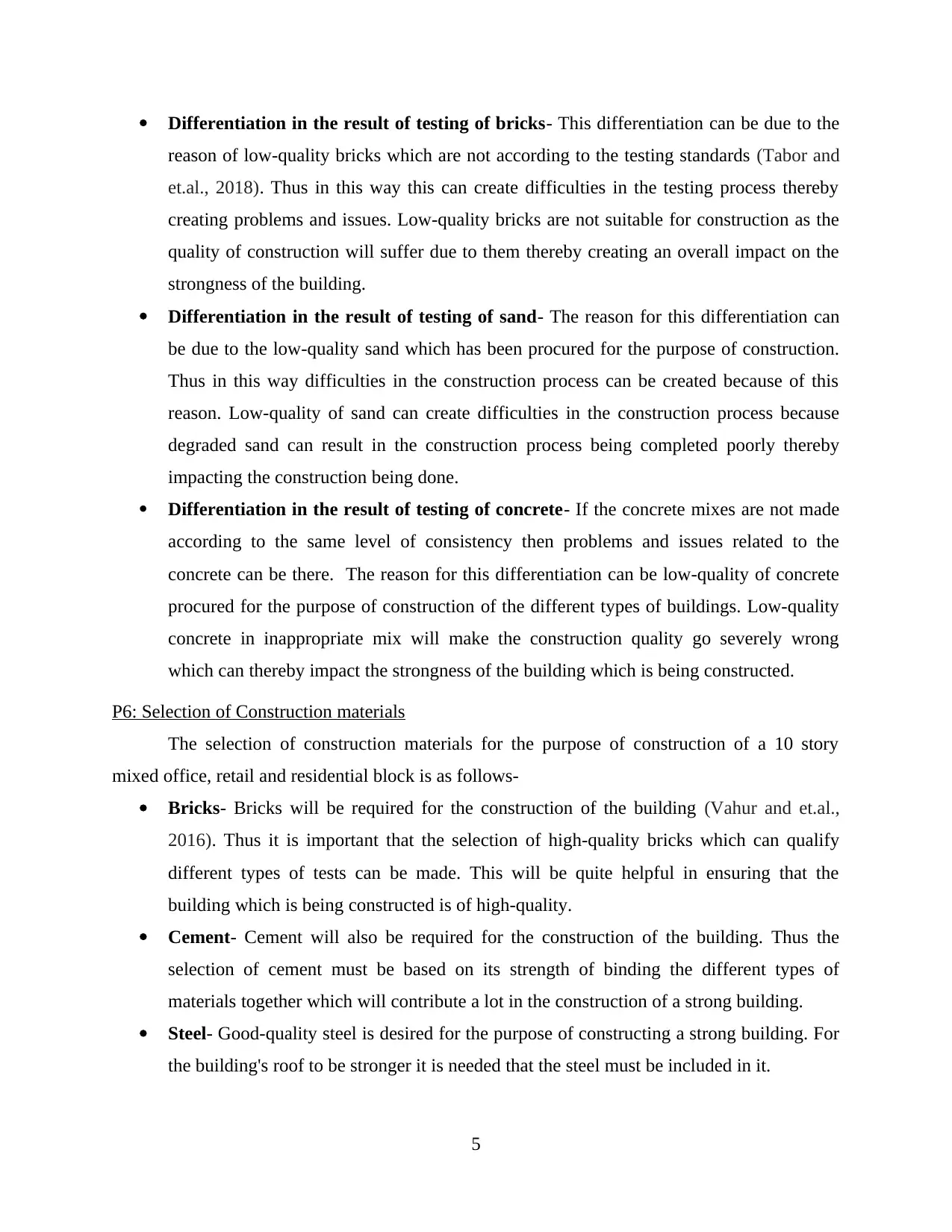
Differentiation in the result of testing of bricks- This differentiation can be due to the
reason of low-quality bricks which are not according to the testing standards (Tabor and
et.al., 2018). Thus in this way this can create difficulties in the testing process thereby
creating problems and issues. Low-quality bricks are not suitable for construction as the
quality of construction will suffer due to them thereby creating an overall impact on the
strongness of the building.
Differentiation in the result of testing of sand- The reason for this differentiation can
be due to the low-quality sand which has been procured for the purpose of construction.
Thus in this way difficulties in the construction process can be created because of this
reason. Low-quality of sand can create difficulties in the construction process because
degraded sand can result in the construction process being completed poorly thereby
impacting the construction being done.
Differentiation in the result of testing of concrete- If the concrete mixes are not made
according to the same level of consistency then problems and issues related to the
concrete can be there. The reason for this differentiation can be low-quality of concrete
procured for the purpose of construction of the different types of buildings. Low-quality
concrete in inappropriate mix will make the construction quality go severely wrong
which can thereby impact the strongness of the building which is being constructed.
P6: Selection of Construction materials
The selection of construction materials for the purpose of construction of a 10 story
mixed office, retail and residential block is as follows-
Bricks- Bricks will be required for the construction of the building (Vahur and et.al.,
2016). Thus it is important that the selection of high-quality bricks which can qualify
different types of tests can be made. This will be quite helpful in ensuring that the
building which is being constructed is of high-quality.
Cement- Cement will also be required for the construction of the building. Thus the
selection of cement must be based on its strength of binding the different types of
materials together which will contribute a lot in the construction of a strong building.
Steel- Good-quality steel is desired for the purpose of constructing a strong building. For
the building's roof to be stronger it is needed that the steel must be included in it.
5
reason of low-quality bricks which are not according to the testing standards (Tabor and
et.al., 2018). Thus in this way this can create difficulties in the testing process thereby
creating problems and issues. Low-quality bricks are not suitable for construction as the
quality of construction will suffer due to them thereby creating an overall impact on the
strongness of the building.
Differentiation in the result of testing of sand- The reason for this differentiation can
be due to the low-quality sand which has been procured for the purpose of construction.
Thus in this way difficulties in the construction process can be created because of this
reason. Low-quality of sand can create difficulties in the construction process because
degraded sand can result in the construction process being completed poorly thereby
impacting the construction being done.
Differentiation in the result of testing of concrete- If the concrete mixes are not made
according to the same level of consistency then problems and issues related to the
concrete can be there. The reason for this differentiation can be low-quality of concrete
procured for the purpose of construction of the different types of buildings. Low-quality
concrete in inappropriate mix will make the construction quality go severely wrong
which can thereby impact the strongness of the building which is being constructed.
P6: Selection of Construction materials
The selection of construction materials for the purpose of construction of a 10 story
mixed office, retail and residential block is as follows-
Bricks- Bricks will be required for the construction of the building (Vahur and et.al.,
2016). Thus it is important that the selection of high-quality bricks which can qualify
different types of tests can be made. This will be quite helpful in ensuring that the
building which is being constructed is of high-quality.
Cement- Cement will also be required for the construction of the building. Thus the
selection of cement must be based on its strength of binding the different types of
materials together which will contribute a lot in the construction of a strong building.
Steel- Good-quality steel is desired for the purpose of constructing a strong building. For
the building's roof to be stronger it is needed that the steel must be included in it.
5
Paraphrase This Document
Need a fresh take? Get an instant paraphrase of this document with our AI Paraphraser
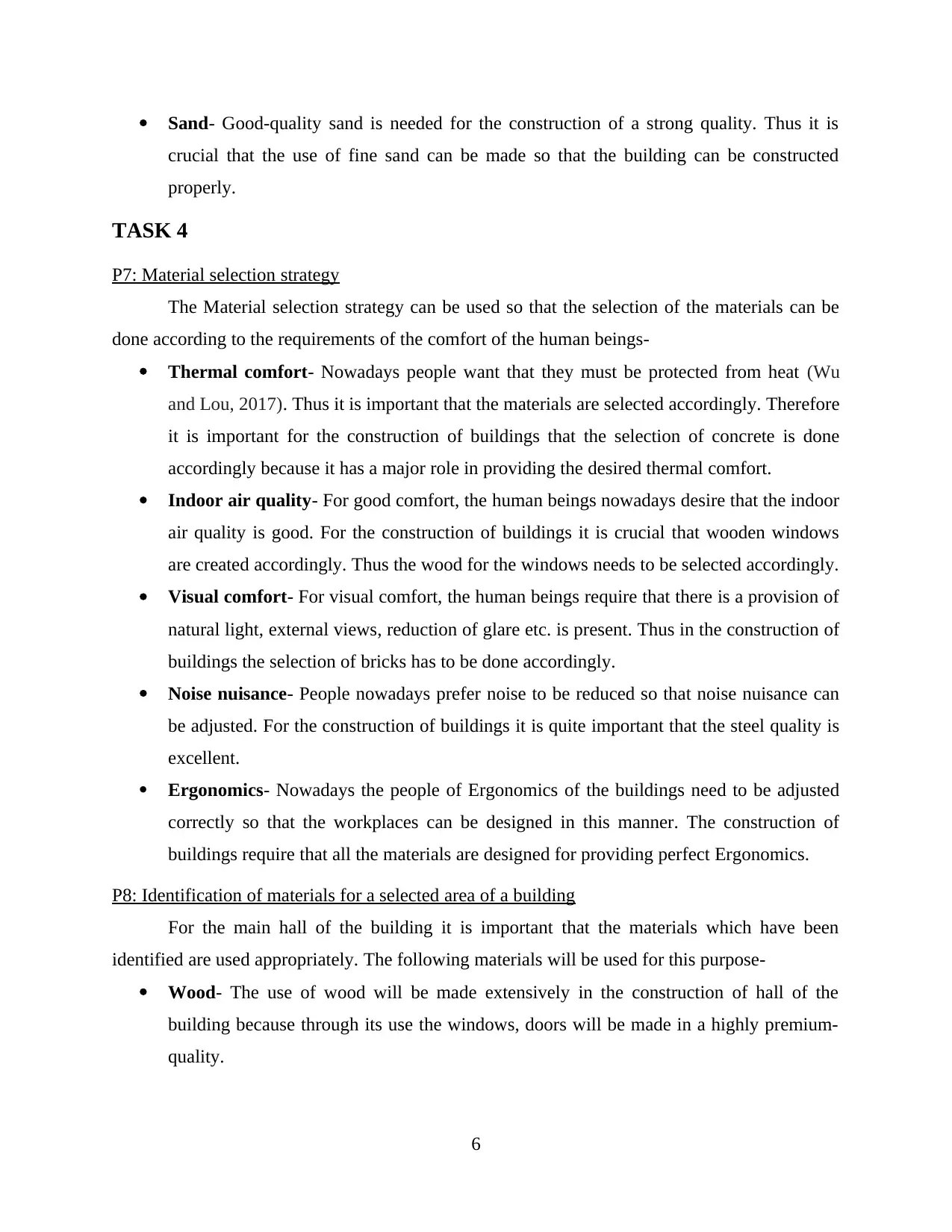
Sand- Good-quality sand is needed for the construction of a strong quality. Thus it is
crucial that the use of fine sand can be made so that the building can be constructed
properly.
TASK 4
P7: Material selection strategy
The Material selection strategy can be used so that the selection of the materials can be
done according to the requirements of the comfort of the human beings-
Thermal comfort- Nowadays people want that they must be protected from heat (Wu
and Lou, 2017). Thus it is important that the materials are selected accordingly. Therefore
it is important for the construction of buildings that the selection of concrete is done
accordingly because it has a major role in providing the desired thermal comfort.
Indoor air quality- For good comfort, the human beings nowadays desire that the indoor
air quality is good. For the construction of buildings it is crucial that wooden windows
are created accordingly. Thus the wood for the windows needs to be selected accordingly.
Visual comfort- For visual comfort, the human beings require that there is a provision of
natural light, external views, reduction of glare etc. is present. Thus in the construction of
buildings the selection of bricks has to be done accordingly.
Noise nuisance- People nowadays prefer noise to be reduced so that noise nuisance can
be adjusted. For the construction of buildings it is quite important that the steel quality is
excellent.
Ergonomics- Nowadays the people of Ergonomics of the buildings need to be adjusted
correctly so that the workplaces can be designed in this manner. The construction of
buildings require that all the materials are designed for providing perfect Ergonomics.
P8: Identification of materials for a selected area of a building
For the main hall of the building it is important that the materials which have been
identified are used appropriately. The following materials will be used for this purpose-
Wood- The use of wood will be made extensively in the construction of hall of the
building because through its use the windows, doors will be made in a highly premium-
quality.
6
crucial that the use of fine sand can be made so that the building can be constructed
properly.
TASK 4
P7: Material selection strategy
The Material selection strategy can be used so that the selection of the materials can be
done according to the requirements of the comfort of the human beings-
Thermal comfort- Nowadays people want that they must be protected from heat (Wu
and Lou, 2017). Thus it is important that the materials are selected accordingly. Therefore
it is important for the construction of buildings that the selection of concrete is done
accordingly because it has a major role in providing the desired thermal comfort.
Indoor air quality- For good comfort, the human beings nowadays desire that the indoor
air quality is good. For the construction of buildings it is crucial that wooden windows
are created accordingly. Thus the wood for the windows needs to be selected accordingly.
Visual comfort- For visual comfort, the human beings require that there is a provision of
natural light, external views, reduction of glare etc. is present. Thus in the construction of
buildings the selection of bricks has to be done accordingly.
Noise nuisance- People nowadays prefer noise to be reduced so that noise nuisance can
be adjusted. For the construction of buildings it is quite important that the steel quality is
excellent.
Ergonomics- Nowadays the people of Ergonomics of the buildings need to be adjusted
correctly so that the workplaces can be designed in this manner. The construction of
buildings require that all the materials are designed for providing perfect Ergonomics.
P8: Identification of materials for a selected area of a building
For the main hall of the building it is important that the materials which have been
identified are used appropriately. The following materials will be used for this purpose-
Wood- The use of wood will be made extensively in the construction of hall of the
building because through its use the windows, doors will be made in a highly premium-
quality.
6
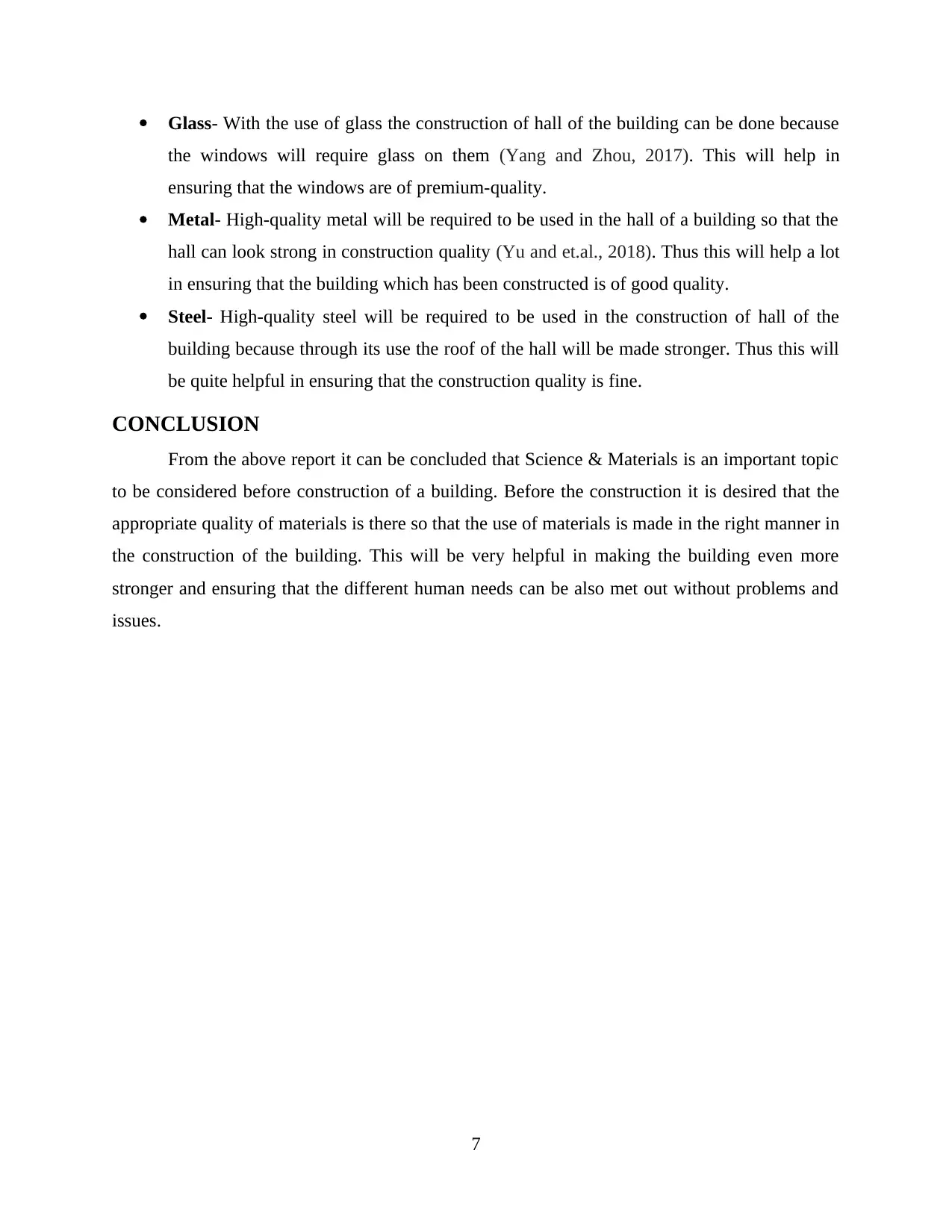
Glass- With the use of glass the construction of hall of the building can be done because
the windows will require glass on them (Yang and Zhou, 2017). This will help in
ensuring that the windows are of premium-quality.
Metal- High-quality metal will be required to be used in the hall of a building so that the
hall can look strong in construction quality (Yu and et.al., 2018). Thus this will help a lot
in ensuring that the building which has been constructed is of good quality.
Steel- High-quality steel will be required to be used in the construction of hall of the
building because through its use the roof of the hall will be made stronger. Thus this will
be quite helpful in ensuring that the construction quality is fine.
CONCLUSION
From the above report it can be concluded that Science & Materials is an important topic
to be considered before construction of a building. Before the construction it is desired that the
appropriate quality of materials is there so that the use of materials is made in the right manner in
the construction of the building. This will be very helpful in making the building even more
stronger and ensuring that the different human needs can be also met out without problems and
issues.
7
the windows will require glass on them (Yang and Zhou, 2017). This will help in
ensuring that the windows are of premium-quality.
Metal- High-quality metal will be required to be used in the hall of a building so that the
hall can look strong in construction quality (Yu and et.al., 2018). Thus this will help a lot
in ensuring that the building which has been constructed is of good quality.
Steel- High-quality steel will be required to be used in the construction of hall of the
building because through its use the roof of the hall will be made stronger. Thus this will
be quite helpful in ensuring that the construction quality is fine.
CONCLUSION
From the above report it can be concluded that Science & Materials is an important topic
to be considered before construction of a building. Before the construction it is desired that the
appropriate quality of materials is there so that the use of materials is made in the right manner in
the construction of the building. This will be very helpful in making the building even more
stronger and ensuring that the different human needs can be also met out without problems and
issues.
7
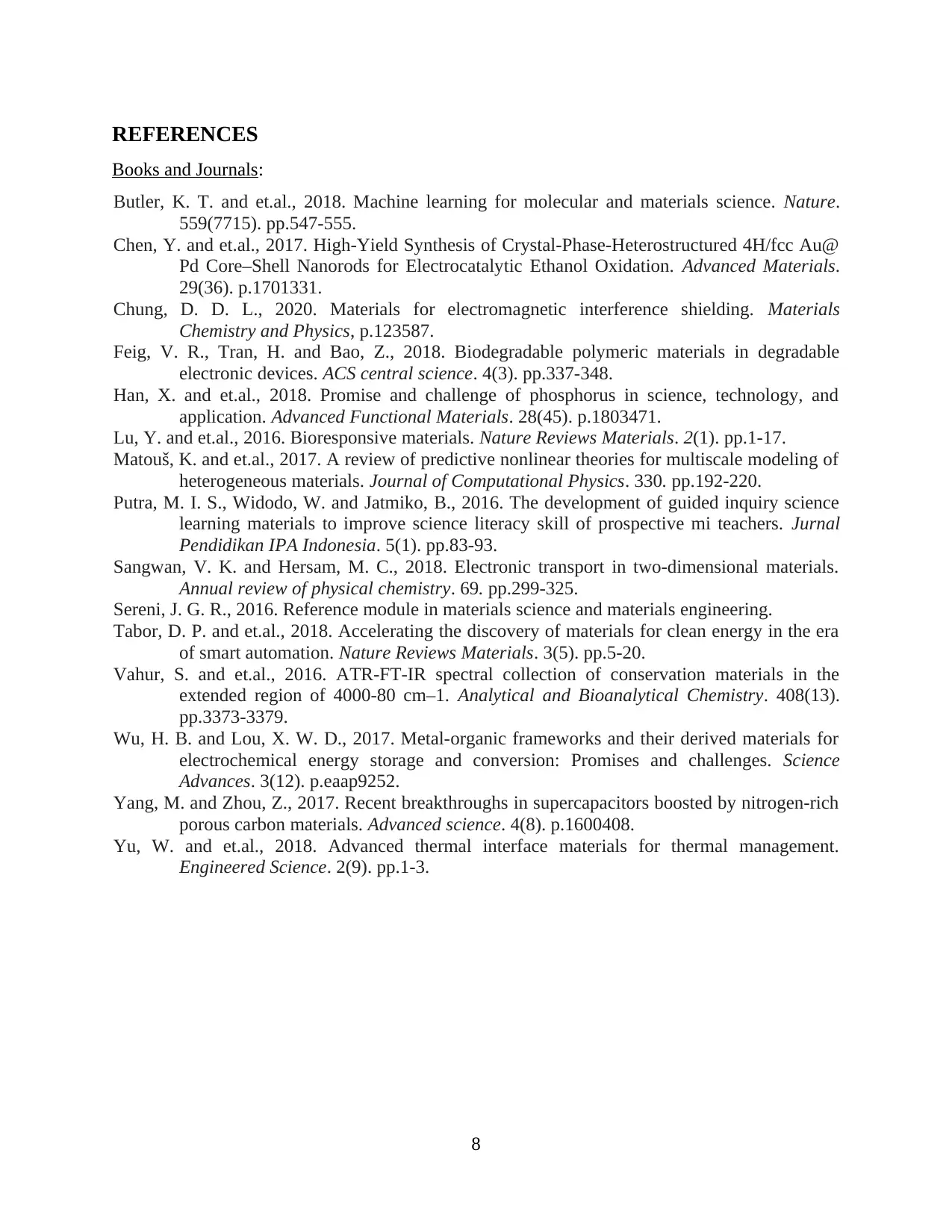
REFERENCES
Books and Journals:
Butler, K. T. and et.al., 2018. Machine learning for molecular and materials science. Nature.
559(7715). pp.547-555.
Chen, Y. and et.al., 2017. High‐Yield Synthesis of Crystal‐Phase‐Heterostructured 4H/fcc Au@
Pd Core–Shell Nanorods for Electrocatalytic Ethanol Oxidation. Advanced Materials.
29(36). p.1701331.
Chung, D. D. L., 2020. Materials for electromagnetic interference shielding. Materials
Chemistry and Physics, p.123587.
Feig, V. R., Tran, H. and Bao, Z., 2018. Biodegradable polymeric materials in degradable
electronic devices. ACS central science. 4(3). pp.337-348.
Han, X. and et.al., 2018. Promise and challenge of phosphorus in science, technology, and
application. Advanced Functional Materials. 28(45). p.1803471.
Lu, Y. and et.al., 2016. Bioresponsive materials. Nature Reviews Materials. 2(1). pp.1-17.
Matouš, K. and et.al., 2017. A review of predictive nonlinear theories for multiscale modeling of
heterogeneous materials. Journal of Computational Physics. 330. pp.192-220.
Putra, M. I. S., Widodo, W. and Jatmiko, B., 2016. The development of guided inquiry science
learning materials to improve science literacy skill of prospective mi teachers. Jurnal
Pendidikan IPA Indonesia. 5(1). pp.83-93.
Sangwan, V. K. and Hersam, M. C., 2018. Electronic transport in two-dimensional materials.
Annual review of physical chemistry. 69. pp.299-325.
Sereni, J. G. R., 2016. Reference module in materials science and materials engineering.
Tabor, D. P. and et.al., 2018. Accelerating the discovery of materials for clean energy in the era
of smart automation. Nature Reviews Materials. 3(5). pp.5-20.
Vahur, S. and et.al., 2016. ATR-FT-IR spectral collection of conservation materials in the
extended region of 4000-80 cm–1. Analytical and Bioanalytical Chemistry. 408(13).
pp.3373-3379.
Wu, H. B. and Lou, X. W. D., 2017. Metal-organic frameworks and their derived materials for
electrochemical energy storage and conversion: Promises and challenges. Science
Advances. 3(12). p.eaap9252.
Yang, M. and Zhou, Z., 2017. Recent breakthroughs in supercapacitors boosted by nitrogen‐rich
porous carbon materials. Advanced science. 4(8). p.1600408.
Yu, W. and et.al., 2018. Advanced thermal interface materials for thermal management.
Engineered Science. 2(9). pp.1-3.
8
Books and Journals:
Butler, K. T. and et.al., 2018. Machine learning for molecular and materials science. Nature.
559(7715). pp.547-555.
Chen, Y. and et.al., 2017. High‐Yield Synthesis of Crystal‐Phase‐Heterostructured 4H/fcc Au@
Pd Core–Shell Nanorods for Electrocatalytic Ethanol Oxidation. Advanced Materials.
29(36). p.1701331.
Chung, D. D. L., 2020. Materials for electromagnetic interference shielding. Materials
Chemistry and Physics, p.123587.
Feig, V. R., Tran, H. and Bao, Z., 2018. Biodegradable polymeric materials in degradable
electronic devices. ACS central science. 4(3). pp.337-348.
Han, X. and et.al., 2018. Promise and challenge of phosphorus in science, technology, and
application. Advanced Functional Materials. 28(45). p.1803471.
Lu, Y. and et.al., 2016. Bioresponsive materials. Nature Reviews Materials. 2(1). pp.1-17.
Matouš, K. and et.al., 2017. A review of predictive nonlinear theories for multiscale modeling of
heterogeneous materials. Journal of Computational Physics. 330. pp.192-220.
Putra, M. I. S., Widodo, W. and Jatmiko, B., 2016. The development of guided inquiry science
learning materials to improve science literacy skill of prospective mi teachers. Jurnal
Pendidikan IPA Indonesia. 5(1). pp.83-93.
Sangwan, V. K. and Hersam, M. C., 2018. Electronic transport in two-dimensional materials.
Annual review of physical chemistry. 69. pp.299-325.
Sereni, J. G. R., 2016. Reference module in materials science and materials engineering.
Tabor, D. P. and et.al., 2018. Accelerating the discovery of materials for clean energy in the era
of smart automation. Nature Reviews Materials. 3(5). pp.5-20.
Vahur, S. and et.al., 2016. ATR-FT-IR spectral collection of conservation materials in the
extended region of 4000-80 cm–1. Analytical and Bioanalytical Chemistry. 408(13).
pp.3373-3379.
Wu, H. B. and Lou, X. W. D., 2017. Metal-organic frameworks and their derived materials for
electrochemical energy storage and conversion: Promises and challenges. Science
Advances. 3(12). p.eaap9252.
Yang, M. and Zhou, Z., 2017. Recent breakthroughs in supercapacitors boosted by nitrogen‐rich
porous carbon materials. Advanced science. 4(8). p.1600408.
Yu, W. and et.al., 2018. Advanced thermal interface materials for thermal management.
Engineered Science. 2(9). pp.1-3.
8
1 out of 10
Related Documents
Your All-in-One AI-Powered Toolkit for Academic Success.
+13062052269
info@desklib.com
Available 24*7 on WhatsApp / Email
![[object Object]](/_next/static/media/star-bottom.7253800d.svg)
Unlock your academic potential
© 2024 | Zucol Services PVT LTD | All rights reserved.





